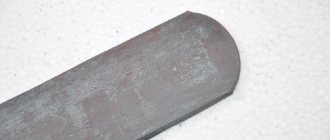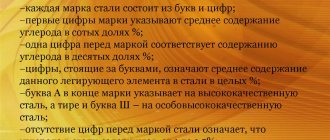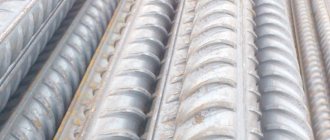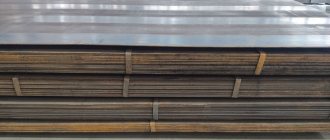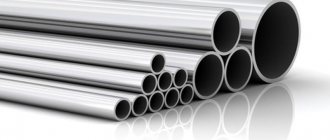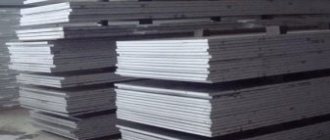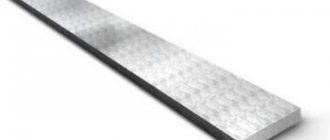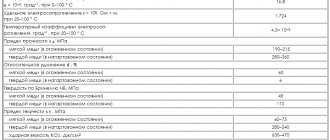A40G - classification and application of the brand
Material classification: Structural steel with increased machinability
Additional material information: Manganese sulfide steel
Application: Parts of complex shape processed on automatic machines, and parts that are subject to increased requirements for cleanliness, surfaces operating under increased stress and pressure: axles, rollers, bushings, rings, gears, pins, screws, bolts, nuts, lead screws.
A40G - chemical composition of the material as a percentage
A40G - mechanical properties at a temperature of 20°
| Assortment | Size | Eg. | s in | s T | d 5 | y | KCU | Thermal change |
| — | mm | — | MPa | MPa | % | % | kJ/m2 | — |
| Hot rolled products, GOST 1414-75 | 590 | 14 | 20 | |||||
| Rolled products calibrated, GOST 1414-75 | 590 | 17 | Annealing |
A40G - technological properties
A40G - foreign analogues
The table shows exact and similar analogues.
| USA | Germany | Japan | France | England | European Union | Italy | Spain | China | Bulgaria | Hungary | Poland | Romania | Czech |
| — | DIN,WNr | JIS | AFNOR | B.S. | EN | UNI | UNE | G.B. | BDS | MSZ | PN | STAS | CSN |
| C1144 | |||||||||||||
| G11410 | |||||||||||||
| G11440 | |||||||||||||
| G11444 | |||||||||||||
| G11460 |
| 46S20 |
|
| ||||||||||||||||||||||||||||||||||||
Steel 40G - decoding of steel grade, GOST, material characteristics
Steel 40G
contains on average 0.4% carbon,
G
- indicates the manganese content in steel is about 1%.
Unalloyed special steel 40G is used for the manufacture of parts that require increased strength: crankshafts, gears, rods, connecting rods, sprockets, camshafts, plunger heads, cardan shafts and other parts.
| Mass fraction of basic chemical elements, % | |||
| C - carbon | Si - silicon | Mn - manganese | |
| 0,37-0,45 | 0,17-0,37 | 0,70-1,00 | |
| Temperature of critical points, °C | |||
| Ac1 | Ac3 | Ar1 | Ar3 |
| 723 | 785 | 680 | 770 |
| Technological properties | |
| Forging | Forging temperature, °C: beginning 1250, end 800. Workpieces with a cross-section of up to 400 mm are cooled in air. |
| Weldability | Limited weldability. Welding methods: manual arc welding, automatic arc welding. Preheating and subsequent heat treatment are recommended. Resistance welding without restrictions. |
| Machinability | In normalized condition at HB 174-207: Kv carbide = 0.95 Kv high speed steel = 0.7 |
| Flokensensibility. | Insensitive |
| Tendency to temper brittleness | Inclined |
| Physical properties | Test temperature, °C | |||||||||
| 20 | 100 | 200 | 300 | 400 | 500 | 600 | 700 | 800 | 900 | |
| Modulus of normal elasticity E, GPa | 200 | — | — | — | — | — | — | — | — | — |
| Modulus of elasticity under torsional shear G, GPa | — | — | — | — | — | — | — | — | — | — |
| Density ρn, kg/m 3 | 7810 | — | — | — | — | — | — | — | — | — |
| Thermal conductivity coefficient λ, W/(m*K) | — | 60 | 53 | — | 47 | 24 | — | — | — | — |
| Electrical resistivity ρ, nOhm*m | — | — | — | — | — | — | — | — | — | — |
| 20-100 | 20-200 | 20-300 | 20-400 | 20-500 | 20-600 | 20-700 | 20-800 | 20-900 | 20-1000 | |
| Linear expansion coefficient α*10 6 , K -1 | 11,1 | 11,7 | 12,7 | — | 14,3 | — | — | — | — | — |
| Specific heat capacity c, J/(kg*K) | 487 | 483 | — | 491 | — | 575 | — | — | — | — |
Mechanical characteristics
| Section, mm | holiday t, °C | sТ|s0.2, MPa | σB, MPa | d5, % | d4 | d10 | d10 | y, % | kJ/m2, kJ/m2 | Brinell hardness, MPa | HRB |
| Flattened tape of medium strength 0.1-4.0 mm according to GOST 10234-77 in delivery condition (delivery condition is indicated) | |||||||||||
| — | — | — | 640-980 | — | — | — | — | — | — | — | — |
| — | — | — | 640-780 | — | — | — | — | — | — | — | — |
| — | — | — | 780-930 | — | — | — | — | — | — | — | — |
| — | — | — | ≤690 | — | — | ≥10 | — | — | — | — | — |
| — | — | — | ≤490 | — | — | — | — | — | — | — | — |
| Heat-treated sheet metal of 1-2 categories (annealing, normalization, high tempering or normalization + high tempering) in delivery condition according to GOST 4041-71 | |||||||||||
| 4-14 | — | — | 510-660 | ≥21 | — | — | ≥17 | — | — | ≤167 | ≤85 |
| Wire for cold heading as delivered in accordance with GOST 5663-79 | |||||||||||
| — | — | — | 560-710 | — | — | — | — | ≥55 | — | — | — |
| — | — | — | ≤740 | — | — | — | — | ≥40 | — | — | — |
| Hot rolled steel and hot rolled steel with special surface finishing | |||||||||||
| — | — | — | — | — | — | — | — | — | — | ≤217 | — |
| — | — | — | — | — | — | — | — | — | — | ≤163 | — |
| Calibrated and calibrated steel with special surface finish | |||||||||||
| — | — | — | — | — | — | — | — | — | — | ≤217 | — |
| — | — | — | ≤590 | — | — | — | — | — | — | ≤197 | — |
| Sheet | |||||||||||
| 80 | — | — | ≥560 | ≥20 | — | — | — | — | — | — | — |
| 80 | — | — | ≥520 | ≥21 | — | — | — | — | — | — | — |
| 4-14 | — | — | 510-650 | ≥21 | — | — | — | — | — | ≤167 | — |
| Ribbon | |||||||||||
| 0.1-4 | — | — | 450-700 | — | ≥14 | — | — | — | — | — | — |
| 0.1-4 | — | — | 850-1050 | — | — | — | — | — | — | — | — |
| Cold rolled strip 0.1-4.0 mm in delivery condition according to GOST 2284-79 | |||||||||||
| — | — | — | 690-1030 | — | — | — | — | — | — | — | — |
| — | — | — | 440-690 | — | ≥14 | — | — | — | — | — | — |
| — | — | — | 440-600 | — | ≥14 | — | — | — | — | — | — |
| Calibrated steel, category 5 | |||||||||||
| — | — | — | ≥610 | ≥6 | — | — | — | ≥35 | — | — | — |
| — | — | — | ≥510 | ≥14 | — | — | — | ≥40 | — | — | — |
| Forgings. Quenching + Tempering | |||||||||||
| 300-500 | — | ≥275 | ≥530 | ≥15 | — | — | — | ≥32 | ≥290 | 156-197 | — |
| 500-800 | — | ≥275 | ≥530 | ≥13 | — | — | — | ≥30 | ≥290 | 156-197 | — |
| 100-300 | — | ≥315 | ≥570 | ≥14 | — | — | — | ≥35 | ≥340 | 167-207 | — |
| 100 | — | ≥345 | ≥590 | ≥18 | — | — | — | ≥45 | ≥590 | 174-217 | — |
| Forgings. Normalization | |||||||||||
| 300-500 | — | ≥215 | ≥430 | ≥18 | — | — | — | ≥40 | ≥440 | 123-167 | — |
| 500-800 | — | ≥215 | ≥430 | ≥16 | — | — | — | ≥35 | ≥390 | 123-167 | — |
| 100-300 | — | ≥245 | ≥470 | ≥19 | — | — | — | ≥42 | ≥390 | 143-179 | — |
| 300-500 | — | ≥245 | ≥470 | ≥17 | — | — | — | ≥35 | ≥340 | 143-179 | — |
| 100-300 | — | ≥275 | ≥530 | ≥17 | — | — | — | ≥38 | ≥340 | 156-197 | — |
| 100 | — | ≥275 | ≥530 | ≥20 | — | — | — | ≥40 | ≥440 | 156-197 | — |
| Hot-rolled thin sheets in delivery condition. Strength group K490V | |||||||||||
| ≤2 | — | — | 490-720 | — | ≥12 | — | — | — | — | — | — |
| 2-3.9 | — | — | 490-720 | — | ≥13 | — | — | — | — | — | — |
| Cold-rolled thin sheets in delivery condition. Strength group K490V | |||||||||||
| ≤2 | — | — | 490-720 | — | ≥13 | — | — | — | — | — | — |
| 2-3.9 | — | — | 490-720 | — | ≥14 | — | — | — | — | — | — |
| Forged blanks of shafts of compressor machines and gas turbines, heat-treated, in delivery condition according to TU NZL 342-89 (longitudinal samples, the strength category is indicated in the delivery condition column) | |||||||||||
| ≤400 | — | ≥274 | ≥509 | ≥17 | — | — | — | ≥35 | ≥343 | — | — |
| Rolled products without heat treatment - delivery condition | |||||||||||
| 60 | — | — | ≥570 | ≥20 | — | — | — | — | — | — | — |
| 6-25 | — | — | ≥570 | ≥19 | — | — | — | ≥45 | — | — | — |
| 80 | — | ≥340 | ≥580 | ≥19 | — | — | — | ≥45 | ≥589 | — | — |
| — | — | ≥340 | ≥600 | ≥16 | — | — | — | — | — | — | — |
| — | — | ≥320 | ≥580 | ≥17 | — | — | — | — | — | — | — |
| Long products and stampings. Quenching in water from 830-850 °C (holding time 2.5-4.0 hours depending on the thickness and weight of the workpiece) + Tempering | |||||||||||
| ≤100 | 580-640 | ≥345 | ≥590 | ≥18 | — | — | — | ≥45 | ≥588 | 174-217 | — |
| Long products and stampings. Hardening in air from 870-890 °C (exposure 2.5-4.0 hours depending on the thickness and weight of the workpiece) | |||||||||||
| ≤300 | — | ≥275 | ≥530 | ≥17 | — | — | — | ≥38 | ≥343 | 156-197 | — |
| Hot-rolled steel, forged calibrated steel and silver steel of the 2nd category after normalization | |||||||||||
| ≤25 | — | — | ≥570 | ≥19 | — | — | — | ≥45 | ≥579 | — | — |
| Long products. Quenching + Tempering | |||||||||||
| — | 200 | ≥750 | ≥930 | ≥7 | — | — | — | ≥45 | — | ≥267 | — |
| — | 300 | ≥710 | ≥860 | ≥8 | — | — | — | ≥51 | — | ≥247 | — |
| — | 400 | ≥640 | ≥790 | ≥10 | — | — | — | ≥57 | — | ≥225 | — |
| — | 500 | ≥550 | ≥730 | ≥12 | — | — | — | ≥62 | — | ≥208 | — |
| — | 600 | ≥450 | ≥660 | ≥16 | — | — | — | ≥66 | — | ≥188 | — |
| — | 700 | ≥380 | ≥620 | ≥17 | — | — | — | ≥71 | — | ≥170 | — |
| Sample with a diameter of 6 mm and a length of 30 mm, rolled. Strain rate 16 mm/min. Strain rate 0.009 1/s | |||||||||||
| — | — | ≥99 | ≥140 | ≥48 | — | — | — | ≥85 | — | — | — |
| — | — | ≥70 | ≥110 | ≥53 | — | — | — | ≥97 | — | — | — |
| — | — | ≥54 | ≥71 | ≥55 | — | — | — | ≥100 | — | — | — |
| — | — | ≥28 | ≥58 | ≥69 | — | — | — | ≥100 | — | — | — |
| — | — | ≥24 | ≥37 | ≥60 | — | — | — | ≥100 | — | — | — |
| — | — | ≥16 | ≥26 | ≥87 | — | — | — | ≥100 | — | — | — |
| — | — | ≥12 | ≥18 | ≥56 | — | — | — | ≥100 | — | — | — |
Structural steel with increased cutting machinability A40G - characteristics, properties, analogues
This page shows the technical, mechanical and other properties, as well as the characteristics of steel grade A40G.
Classification of material and application of grade A40G
Grade: A40G Material classification: Structural steel with increased machinability Application: Parts of complex shape processed on automatic machines, and parts that have increased requirements for cleanliness, surfaces operating at high stresses and pressures: axles, rollers, bushings, rings , gears, pins, screws, bolts, nuts, lead screws.
Chemical composition of A40G material in percentage terms
Mechanical properties of A40G at a temperature of 20 o C
| Assortment | Size | Eg. | sв | sT | d5 | y | KCU | Thermal change |
| — | mm | — | MPa | MPa | % | % | kJ/m2 | — |
| Hot rolled products, GOST 1414-75 | 590 | 14 | 20 | |||||
| Rolled products calibrated, GOST 1414-75 | 590 | 17 | Annealing |
Technological properties of A40G
Explanation of symbols, abbreviations, parameters
| Mechanical properties : | |
| sв | — Short-term strength limit, [MPa] |
| sT | — Proportional limit (yield strength for permanent deformation), [MPa] |
| d5 | — Elongation at break, [%] |
| y | — Relative narrowing, [%] |
| KCU | — Impact strength, [kJ/m2] |
| HB | — Brinell hardness, [MPa] |
Other brands in this category:
Please note that this information about the A40G brand is provided for informational purposes. The parameters, properties and composition of the actual A40G brand material may differ from the values given on this page. More detailed information about the A40G grade can be found on the information resource Brand of steel and alloys. You can check with our managers for information about the availability, delivery times and cost of materials. If you find inaccuracies in the description of materials or errors found, please inform the site administrators using the feedback form. Thanks in advance for your cooperation!
Steel 40 - decoding of steel grade, GOST, material characteristics
Unalloyed special steel 40 is used for the manufacture of crankshafts, connecting rods, ring gears, flywheels, gears, bolts, axles, etc.
After surface hardening with heating by high-frequency currents (high-frequency currents), the steel 40
used for the manufacture of parts that require high surface hardness and increased wear resistance with low deformation (long shafts, rollers, gears).
| Mass fraction of basic chemical elements, % | |||
| C - carbon | Si - silicon | Mn - manganese | |
| 0,37-0,45 | 0,17-0,37 | 0,50-0,80 | |
| Temperature of critical points, °C | |||
| Ac1 | Ac3 | Ar1 | Ar3 |
| 730 | 790 | 690 | 780 |
| Technological properties | |
| Forging | Forging temperature, °C: beginning 1250, end 800. Workpieces with a cross-section of up to 400 mm are cooled in air. |
| Weldability | Limited weldability. Welding methods: manual arc welding, automatic arc welding, electroslag welding. Preheating and subsequent heat treatment are recommended. Resistance welding without restrictions. |
| Machinability | In the hot-rolled state at HB 170 and σв = 520 MPa: Kv hard alloy = 1.2 Kv high-speed steel = 1.05 |
| Flokensensibility. | Not sensitive |
| Tendency to temper brittleness | Not inclined |
Marking of automatic steels
A characteristic feature of free-cut steels is their good machinability on metal-cutting machines. This is achieved primarily by increasing the sulfur content in automatic steels to 0.15-0.35% and phosphorus to 0.10-0.15%. Of course, these elements worsen the mechanical properties of steels, but production benefits from machining costs, since it gets the opportunity to produce non-critical fasteners (bolts, screws, nuts) and small parts in mass production on high-speed automatic lines. Automatic steels include both carbon and alloy steels.
Automatic steels are marked with the letter “A”, which is placed at the beginning of the mark before indicating the amount of carbon: A12, A20, A30, A40G.
In addition to these basic elements (S and P), lead, selenium, and calcium are introduced into automatic steels. The introduction of these elements is reflected in the brand's writing. Lead is designated by the letter “C”, and calcium by the letter “C”. Both of these letters are placed after the letter “A” and before the number indicating carbon in the stamp. Lead-containing grades: AS14, AS40, AS35G2, AS45G2, AS30ХМ, AS40ХГНМ . Lead is introduced in an amount of 0.15¸0.30%. Calcium-containing brands: AC20, AC40, AC60, AC40X, AC35G2, AC30ХМ , etc. The amount of calcium in the brand is negligible: 0.001-0.007%, i.e. does not exceed one hundredth of a percent. And selenium, designated in the stamp by the letter “E”, is placed at the end of the stamp: A35E, A45E, A40XE . The amount of selenium does not exceed a tenth of a percent.
Automatic steels are supplied in accordance with GOST 1414-75.
Bearing steels
Bearing elements (rings, rollers, balls) operate under conditions that require steel to have high hardness, wear resistance and contact fatigue strength. High-carbon (>1%) chromium steels are used as ball bearing steel, and for massive bearings, increased (up to 1%) amounts of manganese and silicon are added to chromium steel.
Bearing steels are supplied in accordance with GOST 801-78. Features of marking steels for bearings: the letter “Ш” is placed at the beginning of the mark, followed by the index of the main alloying element chromium and the subsequent number indicating the chromium content in tenths of a percent. The remaining alloying elements are marked as is customary for alloy steels.
Table 7.1. Composition of bearing steels (GOST 801-78)
| Steel grade | Chemical composition, % | |||
| Carbon | Manganese | Silicon | Chromium | |
| ШХ15 | 0,95-1,05 | 0,20-0,40 | 0,17-0,37 | 1,30-1,65 |
| SHH15SG | 0,95-1,05 | 0,90-1,20 | 0,40-0,65 | 1,30-1,65 |
A characteristic feature of free-cut steels is their good machinability on metal-cutting machines. This is achieved primarily by increasing the sulfur content in automatic steels to 0.15-0.35% and phosphorus to 0.10-0.15%. Of course, these elements worsen the mechanical properties of steels, but production benefits from machining costs, since it gets the opportunity to produce non-critical fasteners (bolts, screws, nuts) and small parts in mass production on high-speed automatic lines. Automatic steels include both carbon and alloy steels.
Automatic steels are marked with the letter “A”, which is placed at the beginning of the mark before indicating the amount of carbon: A12, A20, A30, A40G.
In addition to these basic elements (S and P), lead, selenium, and calcium are introduced into automatic steels. The introduction of these elements is reflected in the brand's writing. Lead is designated by the letter “C”, and calcium by the letter “C”. Both of these letters are placed after the letter “A” and before the number indicating carbon in the stamp. Lead-containing grades: AS14, AS40, AS35G2, AS45G2, AS30ХМ, AS40ХГНМ . Lead is introduced in an amount of 0.15¸0.30%. Calcium-containing brands: AC20, AC40, AC60, AC40X, AC35G2, AC30ХМ , etc. The amount of calcium in the brand is negligible: 0.001-0.007%, i.e. does not exceed one hundredth of a percent. And selenium, designated in the stamp by the letter “E”, is placed at the end of the stamp: A35E, A45E, A40XE . The amount of selenium does not exceed a tenth of a percent.
Automatic steels are supplied in accordance with GOST 1414-75.
Bearing steels
Bearing elements (rings, rollers, balls) operate under conditions that require steel to have high hardness, wear resistance and contact fatigue strength. High-carbon (>1%) chromium steels are used as ball bearing steel, and for massive bearings, increased (up to 1%) amounts of manganese and silicon are added to chromium steel.
Bearing steels are supplied in accordance with GOST 801-78. Features of marking steels for bearings: the letter “Ш” is placed at the beginning of the mark, followed by the index of the main alloying element chromium and the subsequent number indicating the chromium content in tenths of a percent. The remaining alloying elements are marked as is customary for alloy steels.
Table 7.1. Composition of bearing steels (GOST 801-78)
| Steel grade | Chemical composition, % | |||
| Carbon | Manganese | Silicon | Chromium | |
| ШХ15 | 0,95-1,05 | 0,20-0,40 | 0,17-0,37 | 1,30-1,65 |
| SHH15SG | 0,95-1,05 | 0,90-1,20 | 0,40-0,65 | 1,30-1,65 |
Steel A40G – State Enterprise Stalmash
Characteristics of material steel A40G
| steel grade | A40G |
| Steel classification A40G | Structural steel with increased machinability GOST 1414-75 |
| State Enterprise "Stalmash" supplies A40G steel in the following types of rolled metal: GOST 2590-2006 round (hot-rolled steel round), GOST 7417-75 round (calibrated steel round) | |
| Application: | parts of complex shape processed on automatic machines, and parts that are subject to increased requirements for cleanliness, surfaces operating at high stresses and pressures: axles, rollers, bushings, rings, gears, pins, screws, bolts, nuts, lead screws . |
Chemical composition in % of material steel A40G
| C | Si | Mn | S | P |
| 0.37 — 0.45 | 0.15 — 0.35 | 1.2 — 1.55 | 0.18 — 0.3 | up to 0.05 |
Temperature of critical points of the material steel A40G
| Ac1 = 730, Ac3(Acm) = 830 |
Mechanical properties at T=20 o C material steel A40G
| Assortment | Size | Eg. | sв | sT | d5 | y | KCU | Thermal change |
| — | mm | — | MPa | MPa | % | % | kJ/m2 | — |
| The rod is hot rolled. | 590 | 14 | 20 | Delivery status |
| The hardness of the material is hot-rolled steel A40G, | HB 10 -1 = 207 MPa |
| The hardness of the material is steel A40G after high tempering, | HB 10 -1 = 229 MPa |
Technological properties of the material steel A40G
| Flock Sensitivity: | sensitive. |
| Tendency to temper brittleness: | inclined. |
Foreign analogues of the material steel A40G Attention! Both exact and closest analogues are indicated.
| USA | Germany | Japan | France | England | European Union | Italy | Spain | China | Bulgaria | Hungary | Poland | Romania | Czech |
| — | DIN,WNr | JIS | AFNOR | B.S. | EN | UNI | UNE | G.B. | BDS | MSZ | PN | STAS | CSN |
| C1144 | |||||||||||||
| G11410 | |||||||||||||
| G11440 | |||||||||||||
| G11444 | |||||||||||||
| G11460 |
Designations:
| Mechanical properties : | |
| sв | — Short-term strength limit, [MPa] |
| sT | — Proportional limit (yield strength for permanent deformation), [MPa] |
| d5 | — Elongation at break, [%] |
| y | — Relative narrowing, [%] |
| KCU | — Impact strength, [kJ/m2] |
| HB | — Brinell hardness, [MPa] |
| Weldability: | |
| no limits | — welding is performed without heating and without subsequent heat treatment |
| limited weldability | — welding is possible when heated to 100-120 degrees. and subsequent heat treatment |
| difficult to weld | — to obtain high-quality welded joints, additional operations are required: heating to 200-300 degrees. during welding, heat treatment after welding - annealing |
Brand of steel and alloysMetal products from State Enterprise Stalmash, LLC [open for viewing]
A40G in Chelyabinsk
Structural steel with increased machinability
Types of delivery offered by advertisers: No data
parts of complex shape processed on automatic machines, and parts that are subject to increased requirements for cleanliness, surfaces operating at high stresses and pressures: axles, rollers, bushings, rings, gears, pins, screws, bolts, nuts, lead screws .
Finished products offered by advertisers: No data.
Chemical composition in % of material A40G
Temperature of critical points of material A40G
Mechanical properties at T=20 o C of material A40G
Technological properties of material A40G
| Flock Sensitivity: | sensitive |
| Tendency to temper brittleness: | inclined |
Designations:
Mechanical properties:
σв — Short-term strength limit, [MPa] σT — Proportional limit (yield strength for residual deformation), [MPa] δ5 — Elongation at break, [%] Ψ — Relative contraction, [%] KCU — Impact strength, [ kJ / m 2 ]
Weldability:
- without restrictions - welding is performed without heating and without subsequent heat treatment
- limited weldability - welding is possible when heated to 100-120 degrees. and subsequent heat treatment
- difficult to weld - to obtain high-quality welded joints, additional operations are required: heating to 200-300 degrees. during welding, heat treatment after welding - annealing
Material A40G Chelyabinsk
Not a single production can operate without steel, be it heavy engineering or the manufacture of household electrical appliances. There are many brands of this product, as well as a large number of dispensing forms. Our company sells A40G material in large quantities and with a minimal margin. To clarify the properties and characteristics of a particular brand, you can contact the company’s managers.
Like all products, A40G material is purchased from leading manufacturers. Therefore, we are ready to provide a quality guarantee with full responsibility. The minimum number of intermediaries determines the low cost. Coupled with fast delivery, this enables our business partners to conduct stable and mutually beneficial cooperation.
In addition to tempering, in the form of one or another part (blank), our company carries out metal processing. All events undergo strict control for compliance with GOST and rules. The specialists of our company carry out such work as galvanizing, creating parts according to customer drawings, producing castings, manufacturing various profiles and much more.
Having the latest equipment and vast experience in our arsenal, we can offer product testing for a number of parameters, such as strength characteristics, chemical composition, alloy purity, and so on.
Each buyer is offered a huge range of products in various formats, as well as current services and works. To quickly understand and choose a product that meets your needs, you need to contact the company manager and receive detailed information on all issues of interest.

